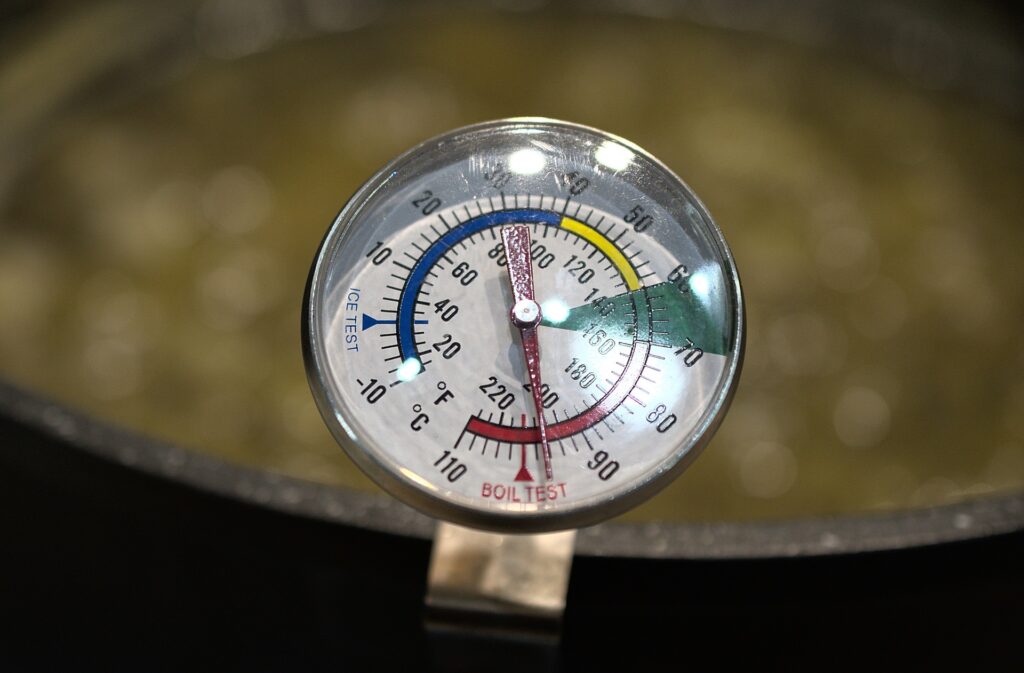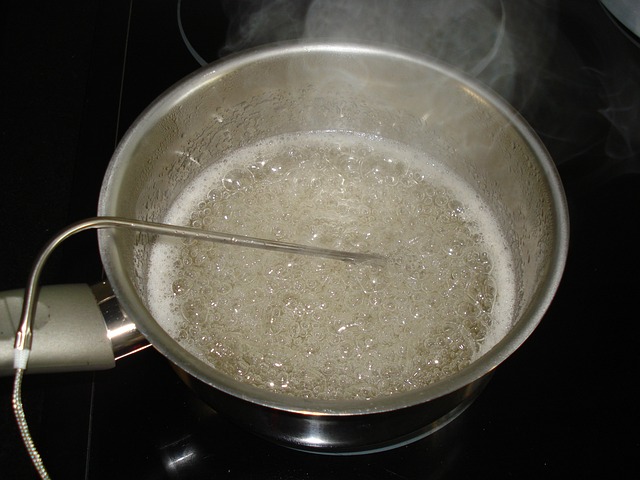Almost any preserving recipe will call for you to cook jam or jelly to a certain temperature. This is so that it reaches a safe boiling point, kills off any potential bacteria, and sets to the desired consistency. But how do you know when your preserves are cooked to the right temperature? A sugar thermometer is key! They often have affordable price points and they’re definitely worth the investment if you plan on doing any preserving.

What is a sugar thermometer?
A sugar thermometer is also known as a jam thermometer or a candy thermometer. You use this specialized kitchen tool to measure the temperature of a sugar syrup. This is esepcially helpful during the process of making a jam or sweets.
The sugar thermometer withstands and measures high temperatures, up to 200+ degrees Celcius/400 degrees Fahrenheit. General design features include a tip that is inserted into the sugar syrup and a handle that stays cool to the touch. And most importatntly,a measurement indicator displaying the temperature.
What is the role of a sugar thermometer in making jam?
Its role is to make sure that the sugar syrup reaches the correct temperature, which is critical for making a successful jam. By measuring the temperature of the sugar syrup, the jam thermometer gives information about the sugar being fully dissolved and also when the preserves reach the desired consistency.

They also have a second use – they can help to prevent sugar crystallization. As sugar is heats, it can begin to form crystals. These crystals can then grow and coalesce, resulting in a grainy texture in the preserve. These thermometers help to prevent this by ensuring that the sugar syrup remains at a consistent temperature. It is this which prohibits crystal formation.
How does a candy thermometer work?
The sugar thermometer is inserted into the jam and the temperature is read from the scale on the thermometer.
Some jam thermometers have a narrow range of temperatures that they can measure, typically between 80°C and 110°C (or 176°F and 230°F). This covers the range of temperatures at which a sugar syrup changes state from a liquid to a solid.
At lower temperatures, the sugar syrup is too thin and will not set. At higher temperatures, the sugar syrup will start to caramelize and will become too dark.
Other thermometers cover a much wider range. This range makes them more versatile and able to be used for your other cooking needs too.
Do I need a jam thermometer to make a jam?
Making jam at home is a great way to enjoy fresh fruit all year long. And while you don’t necessarily need a sugar thermometer to make jam, having one can certainly be helpful.
It comes down to being able to determine the set point of the jam. This is 105 degrees Celcius (220F) for jams and jellies.
Three main methods help determine the set point of jam:
- The Temperature test ( with a jam thermometer)
- The Wrinkle/plate test, and
- The Spoon/flake test.
The temperature test is the most accurate and consistent method. The wrinkle test is less accurate.But it is a good way to get a general idea of the set point. With practice, you can gain confidence with this method.
The spoon/flake test is the least accurate method. It is quick and easy to do and can give you an idea of which stage of development the jam mixture is at.
Common Types of Jam Thermometers.
Dial-type jam thermometer
It consists of a glass tube filled with a liquid. This liquid, typically mercury, expands and contracts as the temperature changes. The liquid is sealed within the glass tube, and a pointer is used to indicate the temperature on a scale.
Analogue dial jam thermometers are less likely to be affected by electrical interference. However, they can be more difficult to read, and they require care when handling them to avoid breakage.
A digital jam thermometer
This allows you to accurately measure the temperature of your jam mixture, ensuring that it reaches the correct setting point. By using a digital jam thermometer, you can also avoid the guesswork and potential mistakes that can occur when using a traditional thermometer.
Simply place the sensor probe in the jam mixture and wait for the digital display to give you an accurate reading. This thermometer is also less prone to breakage.
Clip-on jam thermometer versions
Both of the above can also be found as clip-on jam thermometer versions. While the clip frees your hands and allows you to just keep checking on the temperature as the jam cooks, it is not all plain sailing.
For an accurate assessment of the temperature of cooking syrup, the thermometer reading should be taken from the centre of the pan, where the jam is the hottest. Clipping it to the side may therefore be a less accurate measurement; especially if there is a chance that the thermometer is in a ‘hot spot’ of the pan. It can also interfere with the process of stirring the jam and can become dislodged.
A thermometer as part of another utensil.

These range from pans with thermometers in the handles, and pots with thermometers in the lids, to whisks, spatulas and stirring spoons with in-built thermometers in their handles.
Factors to consider ahead of choosing your jam thermometer:
The purpose you will use it for.
Only for jam-making or for other types of cooking too e.g. meat.
Accuracy
This is an important factor. Check product reviews for such information.
Ease of Calibration and ease of Use
This will help it to be easier to become part of your cooking routines and be of value to this process.
Safety
Risk and potential effects of breakage – this may include the breaking of glass and spillage of mercury or other chemicals. Also, how close to boiling jam will you have to hold the thermometer to take a reading without the risk of burning yourself, must be considered. In the same context speed of reading is also an important factor as you want to avoid having to hold the thermometer in the boiling liquid for too long while it tries to build up to giving you an accurate reading.
Design
Does it have a clip and if so what type of clip? Is it a digital, dial or liquid display? Does it have a glass or metal probe? Easy to store and hold when using? What about other features like an alarm, magnetic, fixed or wired probe etc
Durability
What is its potential breakability, readability, and reliable accuracy over time? As this can determine how often you may need to replace it.
Versatility
Can it be used for other things too e.g. candy/chocolate/meat and other foods or cooking tasks?
Ease of cleaning
Even when it has done all you need from it, this can make or break the experience of using this tool. So make sure that it’s easy to clean and keep hygienic.
Cost
This includes both the financial outlay but also whether you consider that it is of good value to you and becomes a worthwhile kitchen asset.
Take all of this into consideration and decide which of the wide range of available food thermometer products suits you needs and wallet.
A sugar or jam thermometer that is accurate and easy to use, can make all the difference in your preserving. Investing in a quality kitchen gadget can save you time and money in the long run. It can also make the process of creating tasty preserves more enjoyable and smooth.